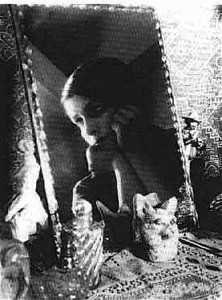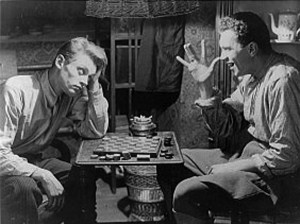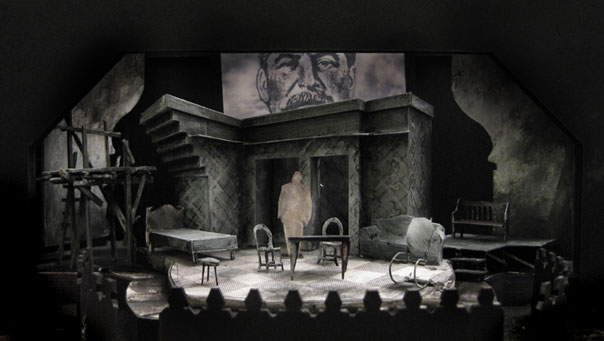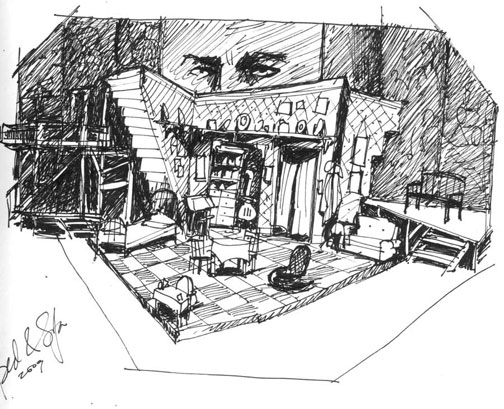Bed and Sofa Background
 Bed and Sofa began its life as the wonderfully scandalous 1926 silent film directed by Abram Room and starring three of the Soviet Union’s most popular actors. For most of the twentieth century, Room’s film received ritual mention in Soviet and Western film histories, but mostly as a footnote in the development of the new art of film.
Bed and Sofa began its life as the wonderfully scandalous 1926 silent film directed by Abram Room and starring three of the Soviet Union’s most popular actors. For most of the twentieth century, Room’s film received ritual mention in Soviet and Western film histories, but mostly as a footnote in the development of the new art of film.
In the 1970’s the movie began to be taken up by a newer generation of film historians, such as Molly Haskell, who began to see it as “one of the most extraordinary feminist films of that [the 1920’s] or any other time.” The film began to make the rounds of various film festivals and began to be recognized for its frank depiction of ‘real life’ and its startling naturalistic acting style. Early American film actors had found their way into new medium of film via the Broadway stage and the circus. The acting style that we often associate with the silent era is one of broad gestures and quirky movement. This was to be expected as that was how actors worked on the stages of their era without the help of microphones, electric stage lighting, and computerized scenery. They needed to be larger and more declamatory to be heard and seen from the balconies. But, film pioneers like D. W. Griffith and Abram Room were busy creating such novel conventions as the ‘closeup’ and the ‘cut away shot,’ and thereby inventing the need for an entirely new style of acting for the film.
And Bed and Sofa was certainly that. It was an experiment in how to tell a simple story on film with only one set, three actors and a hand held camera around the busy streets of Moscow. Room’s team spun a complex and shifting tale of a love triangle in a cramped apartment during a severe housing shortage in modern Moscow. The film was an indictment of the wave of utopian ‘free love’ that came in with the revolution and was being actively stamped out by the Stalinist regime of the 1920s.
When Volodya excitedly comes to the big city to begin work as a printer he is met with the rude shock that due to government regulations, he must have a permanent address in order to hold a job of any kind. And, there is this housing shortage plaguing Moscow. It’s a “Catch Twenty-Two” that is only broken when he happens upon his old friend Kolya in the street who offers him his sofa. When Kolya, his wife, Ludmilla and Volodya set up house in the tiny apartment, a string of shifting alliances, lovers and situations are set into motion.
 Polly Pen and Laurence Klavan’s adaptation of movie is a mini-masterpiece. They obviously spent a great deal of love and devotion to making this story over for the stage. To begin with, the lyrics are adaptations of the title cards in the film. These phrases and musical motifs repeat over and over again. Each new time they are sung, they take on a new context as the story deepens. It’s simple and yet, it’s very complex and extremely specific. They have managed to create a faithful reproduction of the film that still holds its own as a piece of live theatre.
Polly Pen and Laurence Klavan’s adaptation of movie is a mini-masterpiece. They obviously spent a great deal of love and devotion to making this story over for the stage. To begin with, the lyrics are adaptations of the title cards in the film. These phrases and musical motifs repeat over and over again. Each new time they are sung, they take on a new context as the story deepens. It’s simple and yet, it’s very complex and extremely specific. They have managed to create a faithful reproduction of the film that still holds its own as a piece of live theatre.
I’ve been a silent film fan for many years. When we produced this play in 2004, it was just our third production (of 37 now to date!). But it was so well received (by the few people who knew of our new company who actually saw it!), that it has remained one of the most often requested revivals we have. People who saw it ask to be able to see it again. Those who missed it have asked us for an opportunity to see what the fuss was about. We know this: It was due to Bed and Sofa that audiences began to discover what this new company was about and the kind of works we intended to create.
Revisiting it has been a great experience. Rather than a straight re-mount, this version of Bed and Sofa is entirely new. The new cast is different. The set is similar but different, and with the new capabilities of the Old Town Theatre, we are able to flesh this show out even further. It’s both bigger, and smaller. We’ve been enjoying this amazing opportunity to explore the silent film style of acting and story telling. We have been faithful to the original movie and watched it and studied it for inspiration. We admired the acting in the film and then took off and brought our own insights to the piece. We hope you enjoy the surprises in this highly unique mini-silent-movie-opera. It’s both big and small. Not another word.
Bed and Sofa: the latest stage

Andy Hull’s set model for Bed and Sofa.
Today we had our first formal design meeting for our upcoming Bed and Sofa. This is our first opportunity for all of the designers to get together and begin thinking about how all of our design choices are coming together. We want the ultimate product to have a cohesion, so that all of the various elements, each designed by different people, feel like they all belong to the same “world” that we are creating for the play.
As I wrote in an earlier post, the world of Bed and Sofa is that of the silent film. Since the original film was created in Moscow in 1926, we know that the look of the costumes, scenery and props will have a Soviet influence. Since we are trying to capture the feel of a silent film, we are setting the show in a world that is entirely seen in shades of grey, white and black.
Today, Andy Hull the set designer working with me on the show, presented his model of the set. We use this model as the first stage of the over all look. We can make changes on it still, but that time is now coming towards an end, as Nick Fouch, our technical director, now begins to turn the drawings and model into full size pieces made from real wood! Changes really begin to become difficult and expensive.
Here is a photo of Andy’s model. You can compare it to my first sketch. My idea for the set design came from the film. The apartment in the movie is a basement apartment and you can see the underside of the stairs jutting into the room. I liked the shape and tried to tie it in. In the musical the presence of Stalin is felt somehow as a looming Big Brother type. So we played with how to bring him into the design. I handed Andy this sketch and he has been working his magic on it. He cleaned it up and more importantly he added his wonderfully clever touches to it. The back masking flats, which will have collages of various images mentioned in the show, have the silhouette of the onion domes of St. Peters suggested in their shapes. Andy’s great.
We’ll keep you up on the progress.
The black and white world of Bed and Sofa

I am really excited about beginning work on our upcoming musical, Bed and Sofa, by Polly Pen and Laurence Klavan. We did this show as part of our very first season, before many people had even heard about our work. It turned out to be a wonderful success and helped introduce our theatre to a new range of people. I’ve wanted to work on it again because it was one of the most unique experiences I’ve ever had in the theatre.
It’s based on the 1926 Russian silent-film by Abram Room. The movie, which is available on Amazon in beautiful restoration DVD, was a breakthrough film that is startlingly contemporary in it’s acting style and cinematic directing.
As we begin work bringing this musical-adapted-from-a-silent-film-for-the-stage we’re trying to capture the essence of a silent movie. As in our first production, we are creating a world onstage that is completely engulfed in glorious black and white! Every detail of the set from the bedding to the fried egg is presented in shades of grey. Even the actors are in grey scale creating the total illusion of the silver tones of the silent era. Andy Hull, our SDSU Fellowship Designer who designed The History Boys, is working with me on the set design. We are having a great time taking the cramped apartment set from the film and adapting it for the stage. The set from our original production in 2004 is being re-imagined in a slightly bigger version for the Old Town Theatre.
What’s exciting for us is that the new production isn’t a remount at all. It will feature a entirely new cast, as our original Kolya, Eric Anderson is currently on Broadway in the revival of South Pacific, and Julie (Jacobs) Ludlum now resides in Northern California with her husband and two babies and Michael Elliott now lives in Texas. They were wonderful and were recognized for their work with awards from the San Diego Critic’s Circle. But the new cast that is being assembled consists of some of San Diego’s favorite musical performers and I am thrilled and excited to see what they bring to the roles. When I am finished casting I’ll share who they are and maybe they can be convinced to add to this blog as we begin rehearsals.
The production team is top notch. The talented G. Scott Lacy will be music directing and a designer I’ve loved and worked with several years ago, Corey Johnston, will be designing the costumes. Our resident artist lighting designer Eric Lotze is given the challenge of creating a live version of a black and white film and Sam Lerner will be creating a soundscape that evokes the world of Stalin’s Moscow. And the many black and white props, including grey eggs and real black bread, will be created, as always, by Bonnie Durben.
It’s getting exciting. More to come…